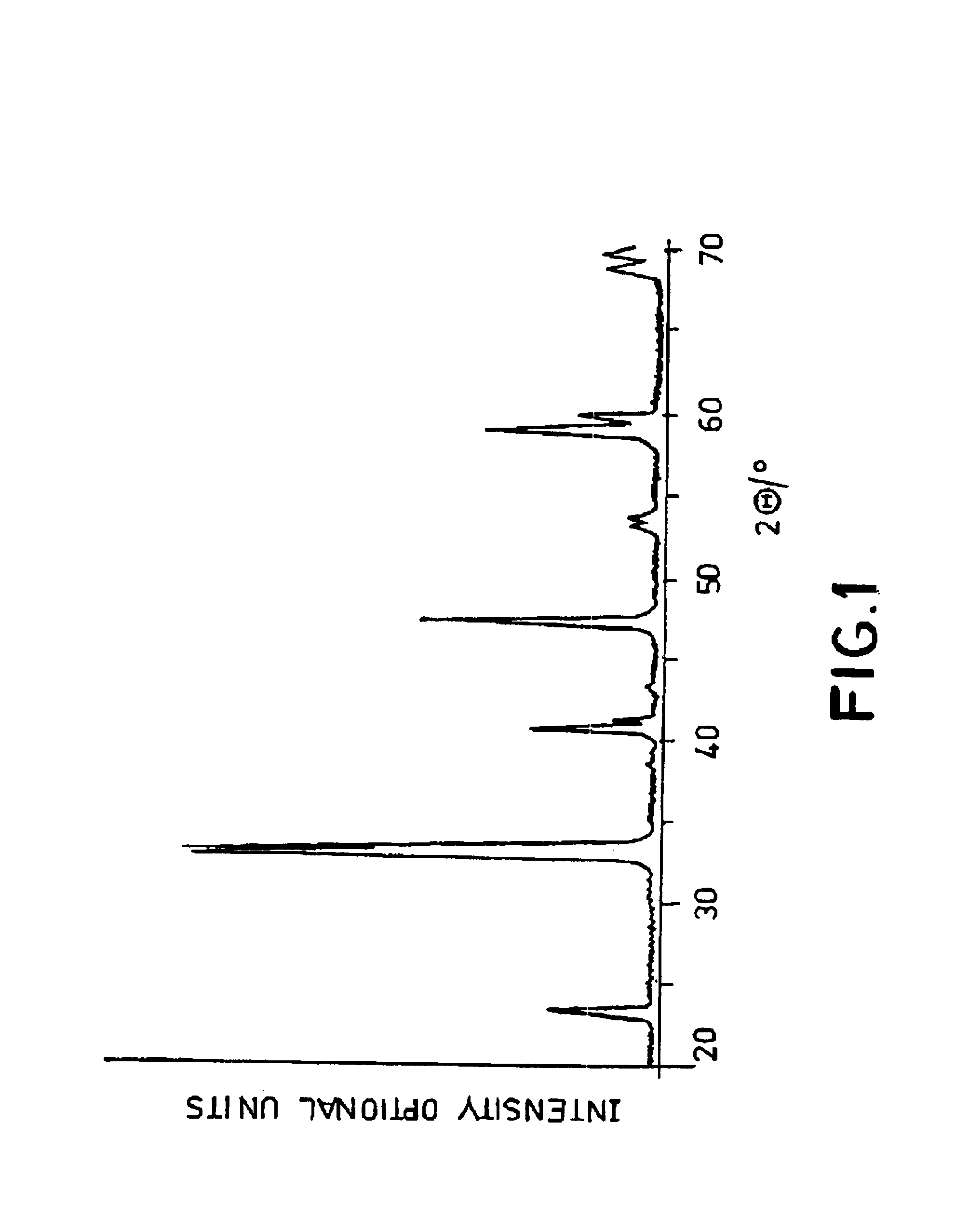Ceramic material and the production thereof
a ceramic material and ceramic technology, applied in the field of ceramic materials and ceramic production, can solve the problems of reducing the stoichiometry of products, requiring very expensive (frequently metal-organic) starting materials and auxiliary materials, and producing only very small quantities, so as to reduce the chemical diffusion gradient and reduce the effect of chemical exchang
- Summary
- Abstract
- Description
- Claims
- Application Information
AI Technical Summary
Benefits of technology
Problems solved by technology
Method used
Image
Examples
example 1
As the first example, the production of a 100 gram powder charge with the desired composition of La.sub.0.8 Ca.sub.0.2 Cr.sub.0.1 Co.sub.0.6 Cu.sub.0.3 O.sub.3 is described. As starting salts the following chemicals were used:
La(NO.sub.3).sub.3.times.6H.sub.2 O=152.7 g
Ca(NO.sub.3).sub.2.times.4H.sub.2 O=20.8 g
Cr(NO.sub.3).sub.3.times.9H.sub.2 O=17.7 g
Co(NO.sub.3).sub.2.times.6H.sub.2 O=77.0 g
Cu(NO.sub.3).sub.2.times.3H.sub.2 O=32.0 g
Citric acid-monohydrate=170.0 g
The weighed-out salts were dissolved in a small amount of distilled water--only as much as was required--with stirring in a quartz vessel with a flat bottom. After complete dissolution of the salts, a twice molar quantity of citric acid was added and also brought into solution to complex the cations.
The mixture was evaporated on a hot plate until a viscous mass was obtained. Then, using a gas burner, the temperature was raised carefully until a solid mass resulted. In this phase mixing can lead to strong foaming because of ...
example 2
Use in a High Temperature Fuel Cell
A high temperature fuel cell is assembled in general from the following components:
An electrolyte of yttria-stabilized zirconium oxide (YSZ), a cathode of lanthanum manganite and an anode of the composite material Ni and YSZ.
In order to generate sufficient power, the individual cells are connected with one another serially to a cell stack. As the electrical connecting component, the so-called interconnector, an Fe--Cr based alloy is suitable. With the aid of ceramic paste made from the above-described powder, the individual cells are connected together and simultaneously fabrication tolerances are bridged. The cell stack for the joining process was subjected to a temperature treatment which hardened the pastes and bonded them by diffusion processes fixedly with the neighboring cell component. The connecting elements had high electrical conductivity under the operating conditions of the fuel cells, matched in thermal expansion coefficients those of ...
example 3
Use With Piezoceramics, For Example, as Contacts For Sensors And Actuators
For the PZT ceramics, smaller thermal expansion coefficients have to be realized than for the use in high temperature fuel cells. For this purpose higher proportions of Y and Cr can be used. Too high a yttrium proportion reduces however the conductivity significantly.
This effect can be compensated however by increasing the A" proportion. The range of variations of the compositions can b summarized as follows:
A'.sub.1-x-y-z Y.sub.z A".sub.x Mn.sub.1-a-b M".sub.a Cu.sub.b O.sub.3
with
A'=(La, Pr, Nd)
A"=(Ca, Sr, Ba)
x=0-0.8 y=0-0.05 z=0.1-0.8
and the cases:
M"=Cr with a=0-0.4 b=0.1-0.6
M"=Fe with a=0-1 b=0.1-0.6
M"=Co with a=0-0.3 b=0.1-0.6
as well as mixtures of the cations Cr, Fe, Co within the indicated limits.
Advantageous are further additions of B"=(Pb, Zr, Ti) with a proportion of up to 0.2 (see also the exemplary compositions l) to n) in connection therewith). Additions in this order of magnitude reduce the chemic...
PUM
| Property | Measurement | Unit |
|---|---|---|
| shrinkage | aaaaa | aaaaa |
| shrinkage | aaaaa | aaaaa |
| temperature | aaaaa | aaaaa |
Abstract
Description
Claims
Application Information
 Login to View More
Login to View More - R&D
- Intellectual Property
- Life Sciences
- Materials
- Tech Scout
- Unparalleled Data Quality
- Higher Quality Content
- 60% Fewer Hallucinations
Browse by: Latest US Patents, China's latest patents, Technical Efficacy Thesaurus, Application Domain, Technology Topic, Popular Technical Reports.
© 2025 PatSnap. All rights reserved.Legal|Privacy policy|Modern Slavery Act Transparency Statement|Sitemap|About US| Contact US: help@patsnap.com



